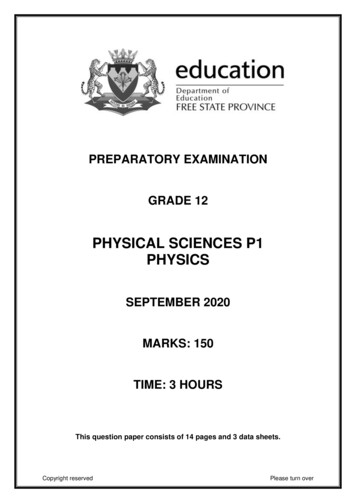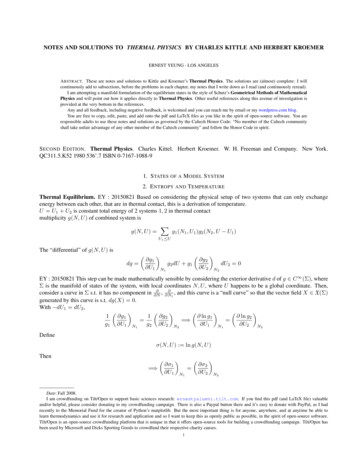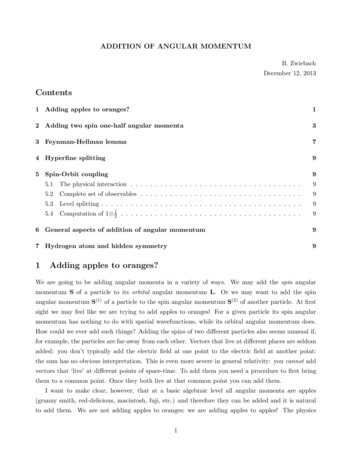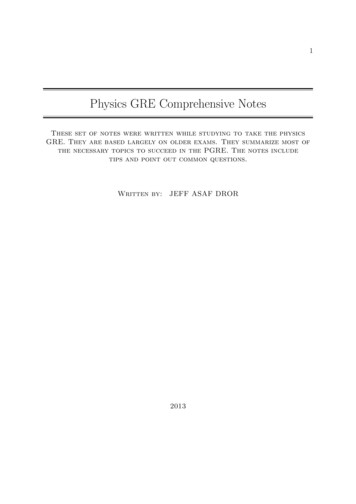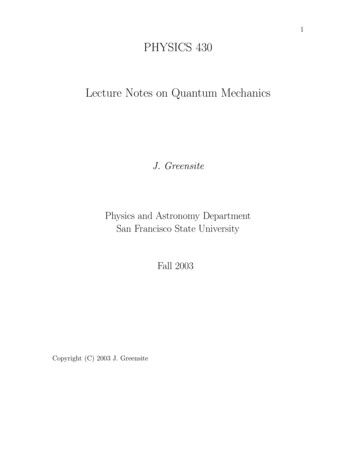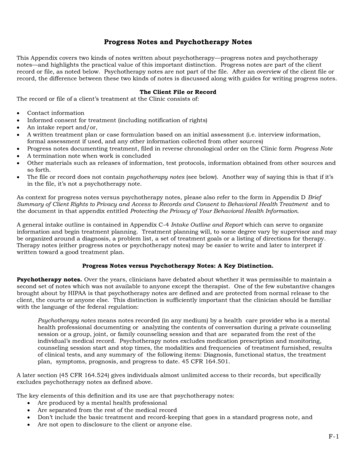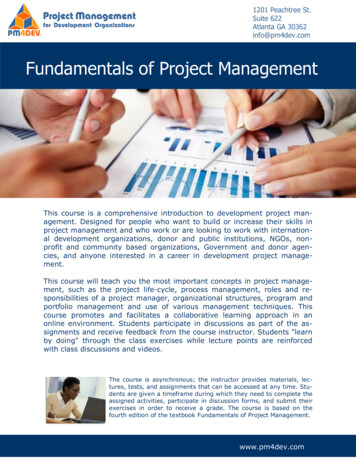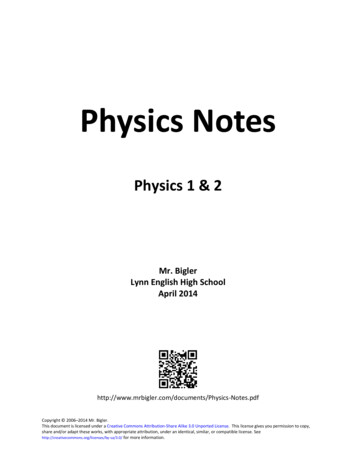
Transcription
Physics NotesPhysics 1 & 2Mr. BiglerLynn English High SchoolApril s.pdfCopyright 2006–2014 Mr. Bigler.This document is licensed under a Creative Commons Attribution-Share Alike 3.0 Unported License. This license gives you permission to copy,share and/or adapt these works, with appropriate attribution, under an identical, similar, or compatible license. Seehttp://creativecommons.org/licenses/by-sa/3.0/ for more information.
This book is the property of:Book No.:Issued toTeacherSchoolYearConditionIssuedReturned
Physics NotesPage 3This is a set of class notes for physics. This hardcopy is provided so that you can fullyparticipate in class discussions without having to worry about writing everything down.While these notes are intended to be reasonably complete, you will probably want to add yourown notes. If you have purchased this copy, you are encouraged to write directly in it, just asyou would write in your own notebook. However, if this copy was issued to you by the schooland intend to return it at the end of the year, you will need to write your supplemental noteson separate paper. If you do this, be sure to write down page numbers in your notes, to makecross-referencing easier.You should bring these notes to class every day. Besides their obvious usefulness in knowing/remembering how to do the homework, in most instances, you will be allowed to use themduring quizzes and tests, because the point of these assessments is not to see what you canremember, but to see how well you can apply what you have learned.These notes will be used with both the Honors and CP Physics I classes. However, the CP courserequires less depth, and will skip some of the topics and sections of these notes.PhysicsMr. Bigler
Physics NotesPage 5Table of ContentsIntroduction . 7Laboratory & Measurement . 13Mathematics . 49Kinematics (Motion) . 87Forces . 113Angular Motion & Torque . 156Energy & Momentum . 167Special Relativity . 199Thermal Physics (Heat) . 223Electricity & Magnetism . 261SHM & Mechanical Waves . 327Light & Optics . 369Pressure & Fluid Mechanics . 421Atomic & Particle Physics. 447Appendix: Reference Tables . 496Index. 511PhysicsMr. Bigler
Cornell NotesAdd ImportantNotes/Cues HerePage: 7Unit: IntroductionCornell NotesUnit: IntroductionNGSS Standards: N/AMA Curriculum Frameworks (2006): N/AKnowledge/Understanding: how to take advantage of the Cornell note-taking systemLanguage Objectives: Understand the term Cornell Notes and be able to describe how CornellNotes are different from ordinary note-taking.Notes:The Cornell note-taking system was developed about fifty years ago at CornellUniversity. I think it’s a great way to get more out of your notes. I think it’s anespecially useful system for adding your comments to someone else’s notes/(such as mine).The main features of the Cornell Notes system are:1. The main section of the page is for what actually gets covered in class.2. The left section (officially 2½ inches, though I have shrunk it to 2 inchesfor these notes) is for “cues”—questions or comments of yours that willhelp you find, remember, or effectively use these notes.3. The bottom section (2 inches) is officially for you to add a 1–2 sentencesummary of the page in your own words. This is a good idea. However,because the rest of the page is my notes, not yours, you may also want touse that space for anything else you want to remember that wasn’t in thepre-printed notes.Use this space for summary and/or additional notes:PhysicsMr. Bigler
Reading & Taking Notes from a TextbookAdd ImportantNotes/Cues HerePage: 8Unit: IntroductionReading & Taking Notes from a TextbookUnit: IntroductionNGSS Standards: N/AMA Curriculum Frameworks (2006): N/ASkills: pre-reading and reading a section of a textbook and taking notesLanguage Objectives: understand and be able to describe the reading and note-taking strategiespresented in this sectionNotes:If you read a textbook the way you would read a novel, you probably won’tremember much of what you read. Before you can understand anything, yourbrain needs enough context to know how to file the information. This is whatAlbert Einstein was talking about when he said, “It is the theory which decideswhat we are able to observe.”When you read a section of a textbook, you need to create some context in yourbrain, and then add a few observations to solidify the context before reading indetail.René Descartes described this process in 1644 in the preface to his Principles ofPhilosophy:"I should also have added a word of advice regarding the manner of reading this work, whichis, that I should wish the reader at first go over the whole of it, as he would a romance,without greatly straining his attention, or tarrying at the difficulties he may perhaps meetwith, and that afterwards, if they seem to him to merit a more careful examination, and hefeels a desire to know their causes, he may read it a second time, in order to observe theconnection of my reasonings; but that he must not then give it up in despair, although hemay not everywhere sufficiently discover the connection of the proof, or understand all thereasonings—it being only necessary to mark with a pen the places where the difficultiesoccur, and continue reading without interruption to the end; then, if he does not grudge totake up the book a third time, I am confident that he will find in a fresh perusal the solutionof most of the difficulties he will have marked before; and that, if any remain, their solutionwill in the end be found in another reading."Use this space for summary and/or additional notes:PhysicsMr. Bigler
Add ImportantNotes/Cues HereReading & Taking Notes from a TextbookPage: 9Unit: IntroductionThe following 4-step system takes about the same amount of time you’re used tospending on reading and taking notes, but it will probably make a tremendousdifference in how much you understand and remember.1. Copy the titles/headings of each section. Leave about ¼ page of spaceafter each one. (Don’t do anything else yet.) This should take about 2–3minutes.2. Do not write anything yet! Look through the section for pictures, graphs,and tables. Take a minute to look at these—the author must havethought they were important. Also read over (but don’t try to answer)the homework questions/problems at the end of the section. (For thevisuals, the author must think these things illustrate something that isimportant enough to dedicate a significant amount of page real estate toit. For the homework problems, these illustrate what the author thinksyou should be able to do once you know the content.) This processshould take about 10–15 minutes.3. Actually read the text, one section at a time. For each section, jot downkeywords and sentence fragments that remind you of the key ideas. Youare not allowed to write more than the ¼ page allotted. (You don't needto write out the details—those are in the book, which you already have!)This process is time consuming, but shorter than what you’re probablyused to doing for your other teachers.4. Read the summary at the end of the chapter or section—this is what theauthor thinks you should know now that you’ve finished the reading. Ifthere’s anything you don’t recognize, go back and look it up. This processshould take about 5–10 minutes.You shouldn’t need to use more than about one sheet of paper (both sides) per10 pages of reading!Use this space for summary and/or additional notes.PhysicsMr. Bigler
Taking Notes on Math ProblemsAdd ImportantNotes/Cues HerePage: 10Unit: IntroductionTaking Notes on Math ProblemsUnit: IntroductionNGSS Standards: N/AMA Curriculum Frameworks (2006): N/ASkills: taking notes on a mathematical problemLanguage Objectives: understand and be able to describe the strategies presented in this sectionNotes:If you were to copy down a math problem and look at it a few days or weekslater, chances are you’ll recognize the problem, but you won’t remember howyou solved it.Solving a math problem is a process. For notes to be useful, they need todescribe the process as it happens, not just the final result.If you want to take good notes on how to solve a problem, you need your notesto show what you did at each step.For example, consider the following physics problem:A 25 kg cart is accelerated from rest to a velocity of 3.5 ms over aninterval of 1.5 s. Find the net force applied to the cart.The process of solving this problem involves applying two equations:v vo at and F ma.Use this space for summary and/or additional notes:PhysicsMr. Bigler
Add ImportantNotes/Cues HereTaking Notes on Math ProblemsPage: 11Unit: IntroductionA good way to document the process is to use a two-column format, in whichyou show the steps of the solution in the left column, and you write anexplanation of what you did and why for each step in the right column.For this problem, a two-column description would look like the following:Stepm 25 kgvo 0v 3.5 mst 1.5 sF quantity desiredF maDescription/ExplanationDefine variables.Choose a formula that contains F. See if we have theother variables. No. We need to find a before we can solvethe problem.v vo atChoose a formula that contains a. See if we have theother variables. Yes.3.5 0 a (1.5)3.5 1.5a3.5 1.5 a1.5 1.52.33 aSubstitute v, vo and t into the 1st equation and solvefor a.F maF (25)(2.33)F 58.33Substitute m and a into the 2nd equation and solvefor F.F 58.33 NInclude the units and box the final answer.Use this space for summary and/or additional notes.PhysicsMr. Bigler
Add ImportantNotes/Cues HereIntroduction: Laboratory & MeasurementPage: 13Unit: Laboratory & MeasurementIntroduction: Laboratory & MeasurementUnit: Laboratory & MeasurementTopics covered in this chapter:The Scientific Method . 15Designing & Performing Experiments . 18Accuracy & Precision. 23Uncertainty & Error Analysis. 25Keeping a Laboratory Notebook . 38Formal Laboratory Reports . 45The purpose of this chapter is to teach skills necessary for designing andcarrying out laboratory experiments, recording data, and writing summariesof the experiment in different formats. Designing & Performing Experiments discusses strategies for coming upwith your own experiments and carrying them out. Accuracy & Precision, Uncertainty & Error Analysis, and Recording andAnalyzing Data discuss techniques for working with the measurementstaken during laboratory experiments. Keeping a Laboratory Notebook and Formal Laboratory Reports discussways in which you might communicate (write up) your laboratoryexperiments.Calculating uncertainty (instead of relying on significant figures) is a new andchallenging skill that will be used in lab write-ups throughout the year.Standards addressed in this chapter:Next Generation Science Standards (NGSS):No NGSS standards are addressed in this chapter.Massachusetts Curriculum Frameworks (2006):No MA curriculum frameworks are specifically addressed in this chapter.Use this space for summary and/or additional notes:PhysicsMr. Bigler
Add ImportantNotes/Cues HereIntroduction: Laboratory & MeasurementPage: 14Unit: Laboratory & MeasurementSkills learned & applied in this chapter: Designing laboratory experiments Error analysis (calculation & propagation of uncertainty) Formats for writing up lab experimentsUse this space for summary and/or additional notes.PhysicsMr. Bigler
The Scientific MethodAdd ImportantNotes/Cues HerePage: 15Unit: Laboratory & MeasurementThe Scientific MethodUnit: Laboratory & MeasurementNGSS Standards: N/AMA Curriculum Frameworks (2006): N/AKnowledge/Understanding Goals: Understand the scientific methodLanguage Objectives: Understand and correctly use terms relating to the scientific method, suchas “peer review”Notes:The scientific method is a fancy name for “figure out what happens by trying it.”In the middle ages, “scientists” were called “philosop
Physics Notes Page 3 Physics Mr. Bigler This is a set of class notes for physics. This hardcopy is provided so that you can fully participate in class discussions without having to worry about writing everything down. While these notes are intended to be reasonably complete, you will probably want to add your own notes. If you have purchased this copy, you are encouraged to write directly in .



